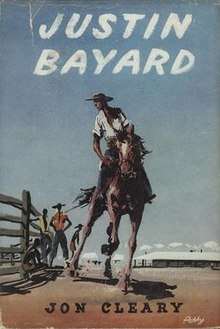Justin Bayard
Justin Bayard is a 1955 novel by Australian author Jon Cleary about a policeman working in the Kimberley region. It was Cleary's sixth novel.
 First edition | |
| Author | Jon Cleary |
|---|---|
| Cover artist | Bruce Petty |
| Country | Australia |
| Language | English |
| Publisher | Collins |
Publication date | 1955 |
| Pages | 320 |
Plot
Justin Bayard is a mounted policeman in the Kimberley escorting an aboriginal warrior, Emu Foot, back to headquarters at Fitzroy Crossing for murdering another aboriginal. Emu Foot is being pursued by warriors from the Kapunda tribe seeking revenge. Bayard is attacked by Kapundas and is badly injured, despite killing several of them. He takes refuge at an isolated cattle homestead Kootapatamba, owned by Tad Kirkbridge.
Bayard soon realises he has walked into a tense domestic situation: Kirkbridge is unhappily married to the neurotic Julie, who is cheating on him with their neighbour, Crispin, and encouraging him to sell Kootapatamba. The head stock manager is Ned Palady whose mixed race daughter Blanche takes a shine to Bayard. Crispin is trying to persuade Kirkbridge to join him in a new method of transporting cattle. Emu Foot is kept prisoner in a boab tree that has been hollowed out but ultimately escapes.
Bayard falls in love with Blanche and fights off another attack from Kapundas. Julie is killed by a spear to the back and Bayard interrogates members of the homestead. He discovers that the killer is Left Hand Spider, an aboriginal stockman who did not want Julie to see Kootapatamba. Spider is killed fleeing Bayard. Emu Foot is also killed by Kapundas.
Bayard and Blanche get married. Tad Kirkbridge sells the homestead to Blanche and her father and Bayard decides to work on it as head stockman.
Background
Cleary researched the book by visiting the Kimberley in March 1954 with his wife, following an extended period of living overseas.[1]
Reception
The novel was generally well received by critics.[2][3] and was Cleary's third novel to be published in the US. The reviewer from the New York Times commented that "Mr Cleary knows his trade; he is a shrewd and intelligent operator. But I wish he would set his heights higher."[4]
The Bulletin called it "a considerable improvement over anything he [Cleary] had hitherto done... Beneath it all throbs the steady pulse of the great engines of the “Saturday Evening Post’’; and if they don’t know how to regulate a popular story, no one does."[5]
It was banned in Ireland.[6]
Film Adaptation
The novel was later filmed as Dust in the Sun (1958), which relocated the action to the Northern Territory.[7] Cleary had little to do with the film even though director Lee Robinson had worked for him in the Army; as late as 2006 he claimed he had never seen it.[8]
References
- "AUTHOR JON CLEARY AND FAMILY RETURN". The Sydney Morning Herald. National Library of Australia. 30 October 1953. p. 11. Retrieved 27 February 2012.
- Review in The Times Literary Supplement 25 November 1955 p.701
- Kylie Tennant, Review in The Sydney Morning Herald 14 January 1956 p.13
- 'Down-under western' (1956, Aug 26). New York Times 26 Aug 1956, pp. BR14
- "'New Cleary Novel". The Bulletin. 21 December 1955. p. 2.
- "DAILY SKETCH BANNED WITH 77 BOOKS" The Irish Times 21 Jan 1956: 9
- ""Jedda" star to rise again". The Argus. Melbourne: National Library of Australia. 9 August 1956. p. 3. Retrieved 27 February 2012.
- Jon Cleary Interviewed by Stephen Vagg: Oral History at National Film and Sound Archive
External links
- Serialisation of the novel in The Argus 1955
- Justin Bayard at AustLit (subscription required)